Bishop Rock Lighthouse
Western rock of Isles of Scilly, Cornwall
|

Featured Location Guide |
|
Bishop Rock Lighthouse, the second tallest
after the
Eddystone
Lighthouse,
 is often referred to as "King of the
Lighthouses" and it is an impressive structure. It stands on a rock ledge 46m long by 16m wide, 4
miles west of the Scilly Isles. The rocks rise sheer from the seabed 45m
below.
is often referred to as "King of the
Lighthouses" and it is an impressive structure. It stands on a rock ledge 46m long by 16m wide, 4
miles west of the Scilly Isles. The rocks rise sheer from the seabed 45m
below.
This is a very exposed location, the
junction in the Atlantic and seas are difficult with up to 30 gales a year
experienced here.
Bishop Rock (Cornish for Men an Eskob) is a small rock at the westernmost tip of
the Isles of Scilly, known for its lighthouse, and listed in the Guinness Book
of Records as the smallest island with a building on it in the world.
Bishop Rock is also the eastern end of the North Atlantic shipping route used by
ocean liners in the first half of the 20th century, the western end being the
entrance to Lower New York Bay. The ship with the fastest time (in either
direction) between a line of longitude running through Bishop Rock and the end
point at the approach to New York Harbour (first Sandy Hook, New Jersey and later
Ambrose Light) claimed the "Blue Riband" for the fastest crossing.
These rocks caused many shipwrecks
including in 1707 when 2,000 men died. Trinity House decided to light the
Scilly Isles to overcome this and chose the most westward rock, Bishops Rock
for the lighthouse.
James Walker, Engineer in Chief to Trinity
House, was against building a solid granite tower arguing that the rock ledge
was too small and the elements too powerful, being exposed as it was to the full
force of the Atlantic Ocean.
|
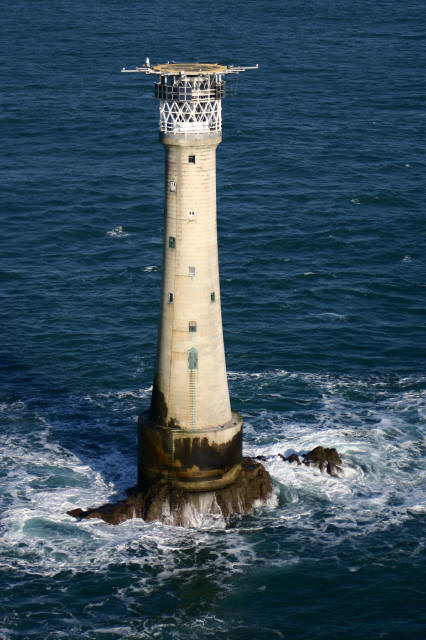
 Picture taken 16th January 2012 by David
Wilkinson
Picture taken 16th January 2012 by David
Wilkinson
|
James Walker demonstrated that the wind pressures
at times exceeded 7,000 lb per sq.ft. Instead he decided on a screw-pile
lighthouse, 120ft tall (37m), design consisting of accommodation, and a light
on top of iron legs. The first task was to sink cast iron legs into the solid
granite, braced and stayed with wrought iron rods. The designer maintained that
the waves would be able to roll freely among the piles instead of being
obstructed by the solid mass of masonry tower. The tower was completed but the
light was never lit, since on 5 February 1850 a storm washed the tower away. It
cost £12,000.
In the second attempt, James Walker decided on a 35m tall design based on the
successful Eddyston
Smeaton's
Tower,
 and he decided on a solid rock able to withstand a base with a 10m diameter.
Even at the lowest tides this was over a foot under the water and a dam had to
be constructed and water pumped out to provide a dry area for the masons to
work. The workmen were housed on a small nearby uninhabited islet within the
Scilly Isles, where living quarters and workshops were erected. All the granite
was despatched from the mainland to the island depot, where it was shaped and
numbered before being sent to the rock. Each granite block, weighing from one to
two tons, was set into its pre-selected position, and each course dovetailed and
keyed into position at the sides, top and the bottom, forming an immovable mass.
and he decided on a solid rock able to withstand a base with a 10m diameter.
Even at the lowest tides this was over a foot under the water and a dam had to
be constructed and water pumped out to provide a dry area for the masons to
work. The workmen were housed on a small nearby uninhabited islet within the
Scilly Isles, where living quarters and workshops were erected. All the granite
was despatched from the mainland to the island depot, where it was shaped and
numbered before being sent to the rock. Each granite block, weighing from one to
two tons, was set into its pre-selected position, and each course dovetailed and
keyed into position at the sides, top and the bottom, forming an immovable mass.The men were carried to and from the site as
the weather permitted. Working spells were brief, as well as being few and far
between, and after seven years labour the tower was finally completed. In
all the 35m tower contained 2,500 tons of dressed granite and cost £34,560. The
light was first shown on 1st September 1858. The total cost for the lighthouse
was £34,559. It was completed with no loss of life.
During one particularly powerful storm, waves
rolled up on the side of the lighthouse and tore away the 550lb fog bell from
its fastenings on the gallery.
In 1881, Sir James Nicholas Douglass inspected the tower, and discovered damage
had occurred and further weaknesses. It was decided to repair and strengthen the
tower and at the same time raise the light by 12m. This involved in effect
constructing a coat or second lighthouse around the existing one.
The major weakness was
the foundation and Douglass proposed to strengthen
|
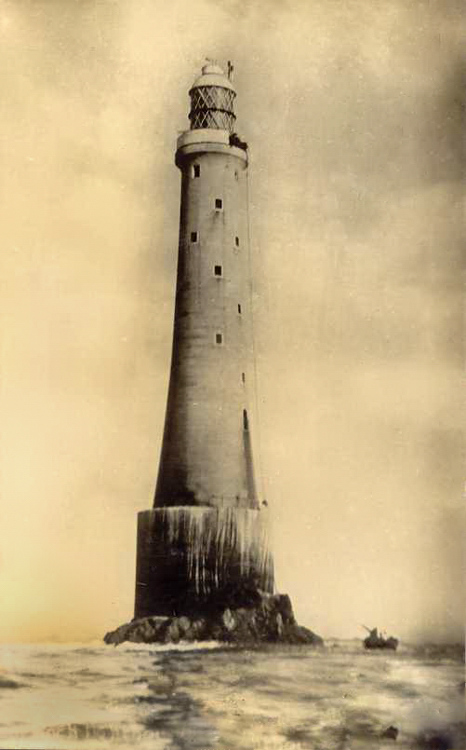
Old image thought to be of Bishops
Rock Lighthouse, Date unknown.
From Camera Images GBPictures archive
 |
This image appears to be the later encased
design but has a piece of the balcony missing, suggesting perhaps that
the incident with the bell being ripped off,
was later than many say. |
|
and enlarge these with
massive blocks of granite sunk into the rock and held there by heavy bolts. It
was an enormous cylindrical base, providing the lighthouse with an major buffer,
onto which the force of the waves could be spent before hitting the tower
itself. The masonry casing, averaging a metre in thickness, was carried up as
far as the new masonry required for the increased height of the light. The
weight of the additional granite was 3,200 tons, making a total weight of 5,700
tons. Work was completed in October 1887 at a cost of £66,000.
The helipad was added in 1973.
Bishop Rock was converted to automatic
operation during 1991 with the last keepers leaving the lighthouse on 21
December 1992. The fog signal was discontinued on 13 June 2007.
The lighthouse formerly had a giant "double"
Fresnel lens, with two lights, although only the lower lens was used most of the
time. Both lights were lit in the fog. Half of this unusual lens is on display
at the National Maritime Museum Cornwall
 in
Falmouth. in
Falmouth.
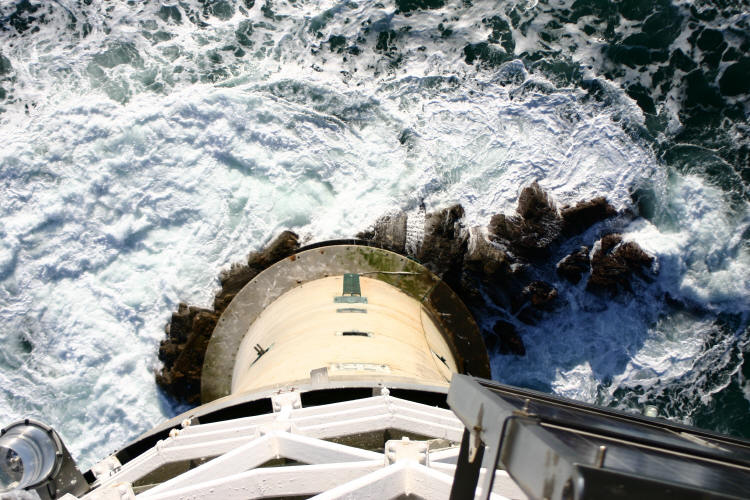
A view from the helipad on
top of the lighthouse
 Picture by David Wilkinson
Picture by David Wilkinson
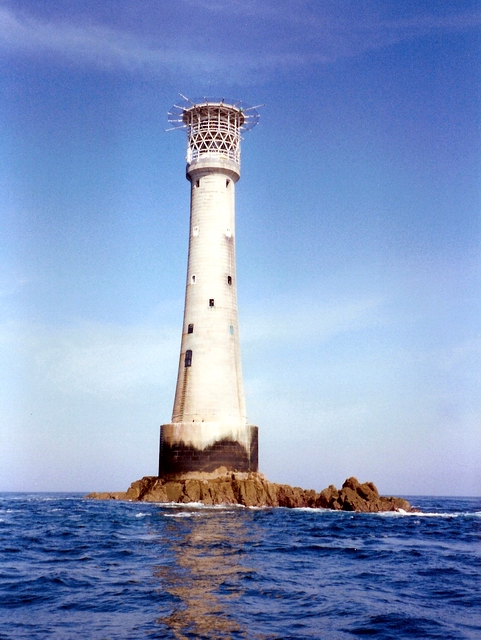
 Image by
Peter
Jordan
Image by
Peter
Jordan

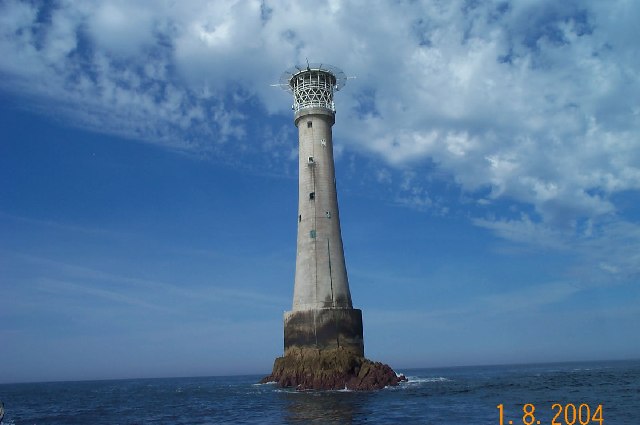
 Picture by
Richard Knites Picture by
Richard Knites

Lighthouse information Grid
|
Name: |
Bishop Rock Lighthouse,
Isles of Scilly, Cornwall |
|
Current status: |
Currently in use |
|
Geographic Position: |
49 52.3 N 06 26.7 W |
|
Grid Reference: |
SV807065 |
|
Ceremonial County: |
Cornwall
 |
|
Appearance: |
Tall granite tower with helipad on top
Round granite tower, incorporating keeper's quarters, with lantern and a
helipad built above the lantern. Tower is unpainted grey stone, lantern and
helipad painted white. |
|
Map
Link: |
maps  StreetMap
StreetMap
 |
|
Aerial photo: |
|
|
Other photos: |
Photo
 Photo.
Photo.
 |
|
Originally built: |
1847 of iron but washed away |
|
Current lighthouse built: |
1851, first lit 1858, encased and extended after 1881 |
|
Height of Tower: |
49m 167ft |
|
Height of light above mean sea level: |
44m 114ft |
|
Character of light: |
2
White Group Flashes Every 15 Seconds |
|
Character of fog signal: |
Fog
signal discontinued 2007
was
one long and one short blast every 90 seconds |
|
Range of light: |
24
miles |
|
Owned / run by: |
Trinity House
 |
|
Getting there: |
|
|
Access: |
|
|
Website: |
TH
 |
|
Other Useful Websites: |
Wiki  |
| Routes: |
|
|
Other Relevant pages: |
For more articles, lists and other information
see the
Lighthouses Section

Lighthouse Map of England and Wales


Featured List of
Lighthouses - England and Wales
 
List of Minor Lighthouses and Lights - England and Wales
 |
|
Notes: |
|
|

|
Please let us know any other information that we
can add to the Grid or page and any errors that you discover. Before making a long trip to any location it is always
wise to double check the current information, websites like magazines may be
correct at the time the information is written, but things change and it is of
course impossible to double check all entries on a regular basis. If you have
any good photographs that you feel would improve the illustration of this page
then please let us have copies. In referring to this page it is helpful if you
quote both the Page Ref and Topic or Section references from the Grid below. To print the
planning grid select it then right click and print the selected area.
Please submit information on locations you discover so
that this system continues to grow.
|